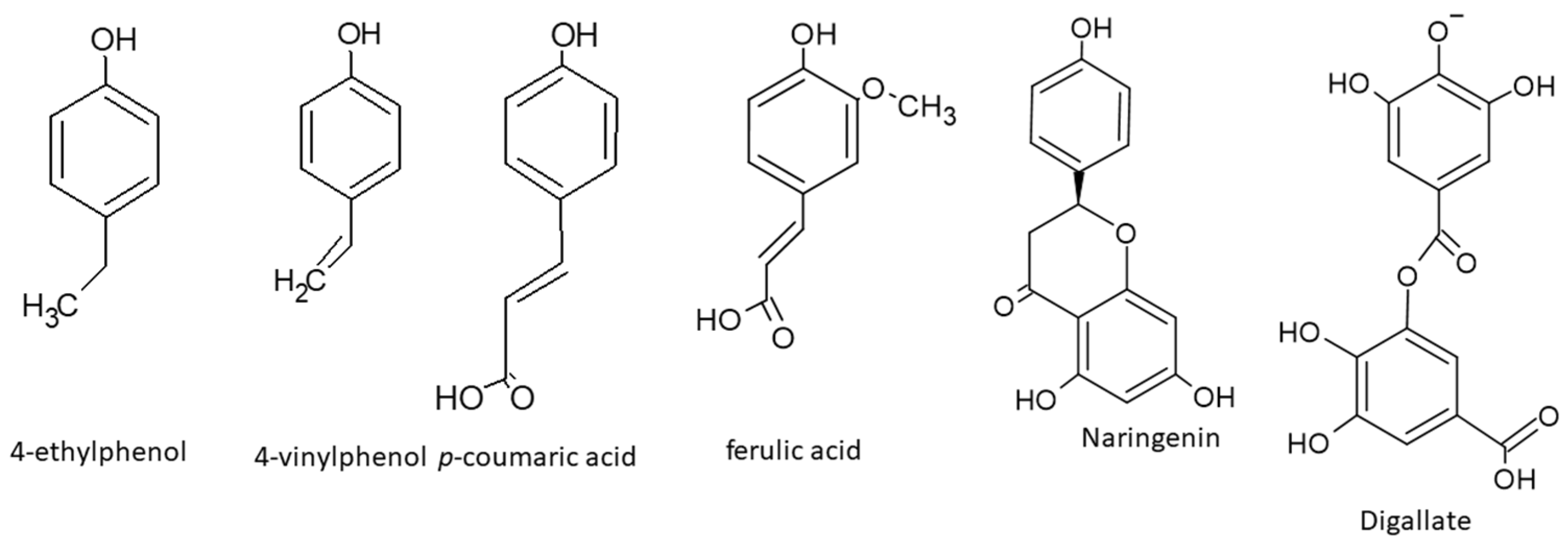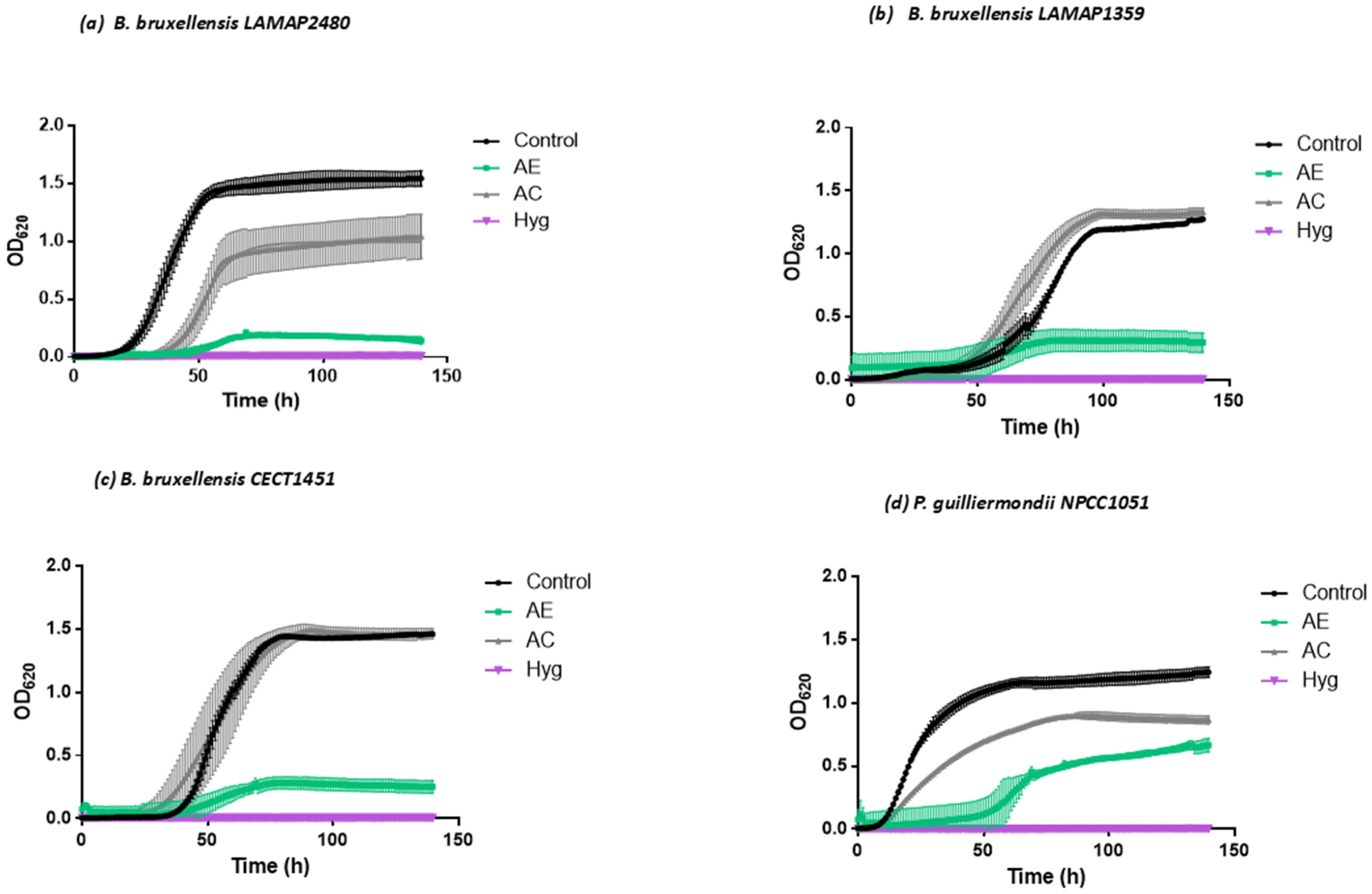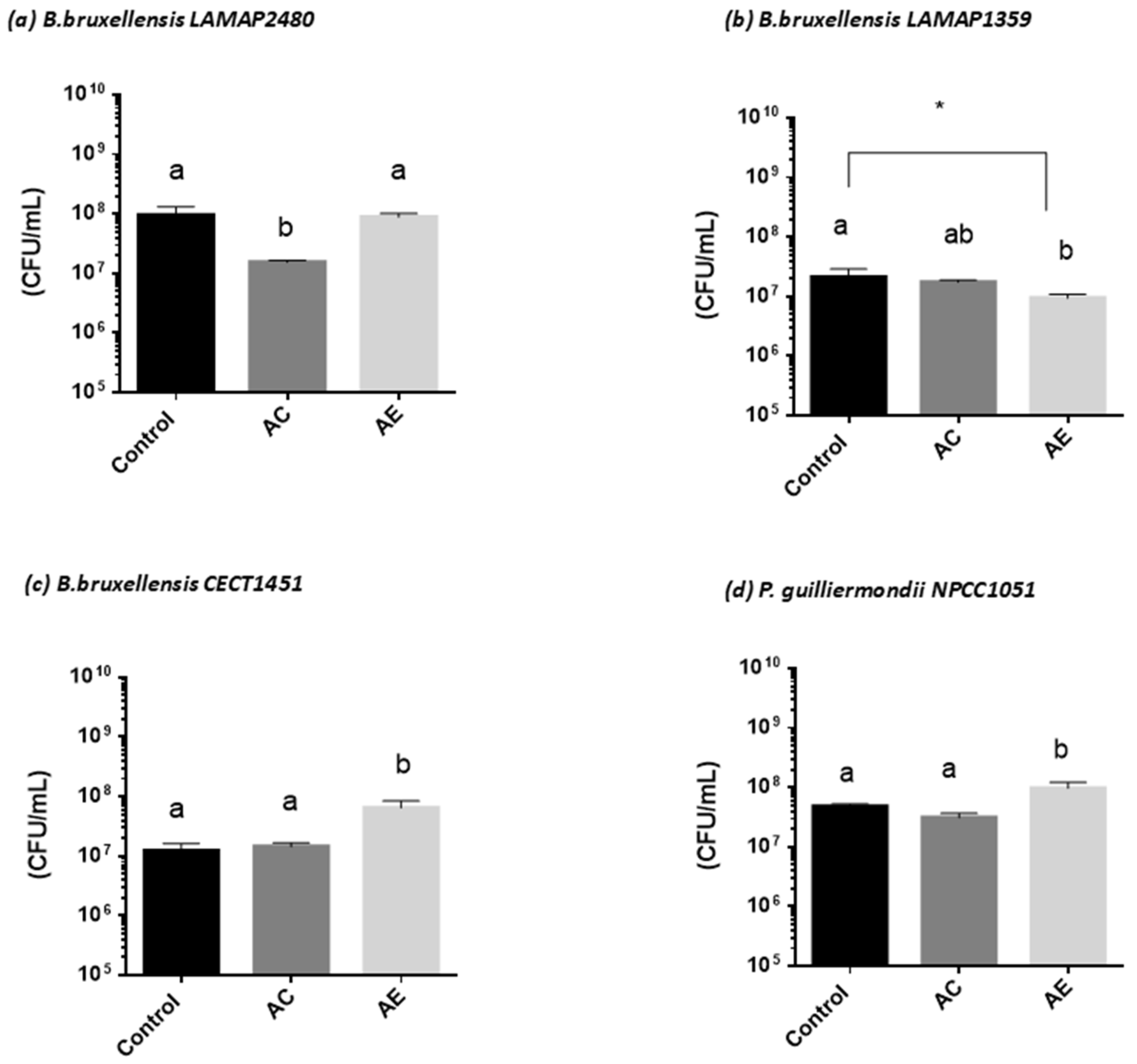Antimicrobial Activity of Leaf Aqueous Extract of Schinus polygamus (Cav.) Cabrera against Pathogenic Bacteria and Spoilage Yeasts
Abstract
:1. Introduction
2. Results and Discussion
2.1. Identification of Schinus polygamus (Cav.) Cabrera
2.2. Quantification of Classic Antimicrobial Compounds in Natural Plants
2.3. Effect on the Growth of Microorganisms
2.4. Evaluation of the Cell Viability of the Tested Microorganisms
3. Conclusions
4. Material and Methods
4.1. Microorganism
4.2. Vegetal Material
4.3. Preparation of Extract
4.4. Quantification of Classic Antimicrobial Compounds in Natural Plants
4.4.1. Hydroxycinnamic Acids
4.4.2. Analysis of Phenolic Content
4.5. Antimicrobial Activity against Bacteria and Yeasts
4.6. Minimum Inhibitory Concentration (MIC)
4.7. Evaluation of Cellular Viability of Microorganisms
4.8. Statistical Analysis
Supplementary Materials
Author Contributions
Funding
Data Availability Statement
Acknowledgments
Conflicts of Interest
References
- Ameme, D.K.; Abdulai, M.; Adjei, E.Y.; Afari, E.A.; Nyarko, K.M.; Asante, D.; Kye-Duodu, G.; Abbas, M.; Sackey, S.; Wurapa, F. Foodborne Disease Outbreak in a Resource-Limited Setting: A Tale of Missed Opportunities and Implications for Response. Pan Afr. Med. J. 2016, 23, 69. [Google Scholar] [CrossRef] [PubMed]
- Hayouni, E.A.; Chraief, I.; Abedrabba, M.; Bouix, M.; Leveau, J.-Y.; Mohammed, H.; Hamdi, M. Tunisian Salvia officinalis L. and Schinus molle L. Essential Oils: Their Chemical Compositions and Their Preservative Effects against Salmonella Inoculated in Minced Beef Meat. Int. J. Food Microbiol. 2008, 125, 242–251. [Google Scholar] [CrossRef]
- Rodríguez Sauceda, E.N. Uso de agentes antimicrobianos naturales en la conservación de frutas y hortalizas. Ra Ximhai 2011, 7, 153–170. [Google Scholar] [CrossRef]
- Leiva, S.; Yáñez, M.; Zaror, L.; Rodríguez, H.; García-Quintana, H. Antimicrobial activity of actinomycetes isolated from aquatic environments in southern Chile. Rev. Med. Chile 2004, 132, 151–159. [Google Scholar] [CrossRef] [PubMed]
- Rhouma, A.; Houcine, B.; Ghanmi, S.; Ben Salah, H.; Romdhane, M.; Demak, M. Antimicrobial Activities of Leaf Extracts of Pistacia and Schinus Species against Some Plant Pathogenic Fungi and Bacteria. J. Plant Pathol. 2009, 91, 339–345. [Google Scholar]
- Ecevit, K.; Barros, A.A.; Silva, J.M.; Reis, R.L. Preventing Microbial Infections with Natural Phenolic Compounds. Future Pharmacol. 2022, 2, 460–498. [Google Scholar] [CrossRef]
- Isah, T. Stress and Defense Responses in Plant Secondary Metabolites Production. Biol. Res. 2019, 52, 39. [Google Scholar] [CrossRef]
- Salazar-Aranda, R.; Pérez-López, L.A.; López-Arroyo, J.; Alanís-Garza, B.A.; Waksman de Torres, N. Antimicrobial and Antioxidant Activities of Plants from Northeast of Mexico. Evid.-Based Complement. Altern. Med. 2011, 2011, 536139. [Google Scholar] [CrossRef] [PubMed]
- Schulze-Kaysers, N.; Feuereisen, M.M.; Schieber, A. Phenolic Compounds in Edible Species of the Anacardiaceae Family—A Review. RSC Adv. 2015, 5, 73301–73314. [Google Scholar] [CrossRef]
- Sova, M.; Saso, L. Natural Sources, Pharmacokinetics, Biological Activities and Health Benefits of Hydroxycinnamic Acids and Their Metabolites. Nutrients 2020, 12, 2190. [Google Scholar] [CrossRef]
- Takó, M.; Kerekes, E.B.; Zambrano, C.; Kotogán, A.; Papp, T.; Krisch, J.; Vágvölgyi, C. Plant Phenolics and Phenolic-Enriched Extracts as Antimicrobial Agents against Food-Contaminating Microorganisms. Antioxidants 2020, 9, 165. [Google Scholar] [CrossRef] [PubMed]
- Bouarab-Chibane, L.; Forquet, V.; Lantéri, P.; Clément, Y.; Léonard-Akkari, L.; Oulahal, N.; Degraeve, P.; Bordes, C. Antibacterial Properties of Polyphenols: Characterization and QSAR (Quantitative Structure-Activity Relationship) Models. Front. Microbiol. 2019, 10, 829. [Google Scholar] [CrossRef] [PubMed]
- Sánchez-Maldonado, A.F.; Schieber, A.; Gänzle, M.G. Structure-Function Relationships of the Antibacterial Activity of Phenolic Acids and Their Metabolism by Lactic Acid Bacteria. J. Appl. Microbiol. 2011, 111, 1176–1184. [Google Scholar] [CrossRef] [PubMed]
- Godoy, L.; Varela, J.; Martínez, C.; Ganga, M.A. The Effect of Hydroxycinnamic Acids on Growth and H+-ATPase Activity of the Wine Spoilage Yeast, Dekkera Bruxellensis. Afr. J. Microbiol. Res. 2013, 7, 5300–5305. [Google Scholar] [CrossRef]
- Godoy, L.; Vera-Wolf, P.; Martinez, C.; Ugalde, J.A.; Ganga, M.A. Comparative Transcriptome Assembly and Genome-Guided Profiling for Brettanomyces Bruxellensis LAMAP2480 during p-Coumaric Acid Stress. Sci. Rep. 2016, 6, 34304. [Google Scholar] [CrossRef] [PubMed]
- Molina-Salinas, G.M.; Pérez-López, A.; Becerril-Montes, P.; Salazar-Aranda, R.; Said-Fernández, S.; de Torres, N.W. Evaluation of the Flora of Northern Mexico for in Vitro Antimicrobial and Antituberculosis Activity. J. Ethnopharmacol. 2007, 109, 435–441. [Google Scholar] [CrossRef] [PubMed]
- Gómez, Í.C.; Huerta, A.; Sandoval, C.A.; Araya, J.E. Insecticide Effect of Leaf Extracts from Schinus Molle on Larvae of Gonipterus Platensis. Rev. Fac. Nac. Agron. Medellín 2017, 70, 8263–8270. [Google Scholar] [CrossRef]
- Chiffelle, I.; Huerta, A.; Celis, M.; Araya, J.E. Proximal Analysis and Insecticidal Effects of Extracts from Pepper Tree (Schinus Molle) Leaves on Elm Leaf Beetle (Xanthogaleruca Luteola) Larvae. Ind. Crop. Prod. 2013, 43, 523–528. [Google Scholar] [CrossRef]
- Guetchueng, S.; Nahar, L.; Ritchie, K.; Daud, F.; Dempster, N.; Nnaga, E.; Sarker, S. Phenolic Compounds from the Leaves and Stem Bark Pseudospondia Microcarpa (A. Rich.) Engl (Anacardiacea). In Biochemical Sytematic and Ecology; Elsevier: Amsterdam, The Netherlands, 2020. [Google Scholar]
- El–Nashar, H.; Mostafa, N.; El-Badry, M.; Eldahshan, O.; Singab, A. Chemical Composition, Antimicrobial and Cytotoxic Activities of Essential Oils from Schinus Polygamous (Cav.) Cabrera Leaf and Bark Grown in Egypt. Nat. Prod. Res. 2021, 35, 5369–5372. [Google Scholar] [CrossRef]
- Turchetti, G.; Garzoli, S.; Laghezza Masci, V.; Sabia, C.; Iseppi, R.; Giacomello, P.; Tiezzi, A.; Ovidi, E. Antimicrobial Testing of Schinus molle (L.) Leaf Extracts and Fractions Followed by GC-MS Investigation of Biological Active Fractions. Molecules 2020, 25, 1977. [Google Scholar] [CrossRef]
- Erazo, S.; Delporte, C.; Negrete, R.; García, R.; Zaldívar, M.; Iturra, G.; Caballero, E.; López, J.L.; Backhouse, N. Constituents and Biological Activities of Schinus Polygamus. J. Ethnopharmacol. 2006, 107, 395–400. [Google Scholar] [CrossRef]
- El-Nashar, H.A.S.; Mostafa, N.M.; Eldahshan, O.A.; Singab, A.N.B. A New Antidiabetic and Anti-Inflammatory Biflavonoid from Schinus Polygama (Cav.) Cabrera Leaves. Nat. Prod. Res. 2022, 36, 1182–1190. [Google Scholar] [CrossRef]
- Fernandes, D.; Salas, C.; Rothmann, S.; Lara, R.I.R.; Perioto, N.W. Megastigmus Transvaalensis (Hymenoptera: Torymidae) on Schinus Polygamus (Anacardiaceae): A New Native Host for This Invasive Seed-Feeding Species. Idesia 2014, 32, 119–122. [Google Scholar] [CrossRef]
- González, S.; Guerra, P.E.; Bottaro, H.; Molares, S.; Demo, M.S.; Oliva, M.M.; Zunino, M.P.; Zygadlo, J. Aromatic Plants from Patagonia. Part I. Antimicrobial Activity and Chemical Composition of Schinus Polygamus(Cav.) Cabrera Essential Oil. Flavour Fragr. J. 2004, 19, 36–39. [Google Scholar] [CrossRef]
- Volpini-Klein, A.F.N.; Silva, C.A.A.; Fernandes, S.S.L.; Nicolau, C.L.; Cardoso, C.A.L.; Fiorucci, A.R.; Simionatto, E. Effect of Leaf and Fruit Extracts of Schinus Molle on Oxidative Stability of Some Vegetables Oils under Accelerated Oxidation. Grasas Aceites 2020, 71, 363. [Google Scholar] [CrossRef]
- El-Massry, K.F.; El-Ghorab, A.H.; Shaaban, H.A.; Shibamoto, T. Chemical Compositions and Antioxidant/Antimicrobial Activities of Various Samples Prepared from Schinus Terebinthifolius Leaves Cultivated in Egypt. J. Agric. Food Chem. 2009, 57, 5265–5270. [Google Scholar] [CrossRef]
- Tan, M.; Tan, C.; Ho, C.W. Effects of Extraction Solvent System, Time and Temperature on Total Phenolic Content of Henna (Lawsonia Inermis) Stems. Int. Food Res. J. 2013, 20, 3117–3123. [Google Scholar]
- Pudziuvelyte, L.; Liaudanskas, M.; Jekabsone, A.; Sadauskiene, I.; Bernatoniene, J. Elsholtzia ciliata (Thunb.) Hyl. Extracts from Different Plant Parts: Phenolic Composition, Antioxidant, and Anti-Inflammatory Activities. Molecules 2020, 25, 1153. [Google Scholar] [CrossRef] [PubMed]
- Tlili, N.; Yahia, Y.; Feriani, A.; Labidi, A.; Ghazouani, L.; Nasri, N.; Saadaoui, E.; Khaldi, A. Schinus Terebinthifolius vs Schinus Molle: A Comparative Study of the Effect of Species and Location on the Phytochemical Content of Fruits. Ind. Crop. Prod. 2018, 122, 559–565. [Google Scholar] [CrossRef]
- da Silva, M.M.; Iriguchi, E.K.K.; Kassuya, C.A.L.; Vieira, M.d.C.; Foglio, M.A.; Carvalho, J.E.d.; Ruiz, A.L.T.G.; Souza, K.d.P.; Formagio, A.S.N. Schinus Terebinthifolius: Phenolic Constituents and in Vitro Antioxidant, Antiproliferative and in Vivo Anti-Inflammatory Activities. Rev. Bras. Farmacogn. 2017, 27, 445–452. [Google Scholar] [CrossRef]
- Chirinos, R.; Pedreschi, R.; Rogez, H.; Larondelle, Y.; Campos, D. Phenolic Compound Contents and Antioxidant Activity in Plants with Nutritional and/or Medicinal Properties from the Peruvian Andean Region. Ind. Crop. Prod. 2013, 47, 145–152. [Google Scholar] [CrossRef]
- Garzoli, S.; Laghezza Masci, V.; Turchetti, G.; Pesci, L.; Tiezzi, A.; Ovidi, E. Chemical Investigations of Male and Female Leaf Extracts from Schinus molle L. Nat. Prod. Res. 2019, 33, 1980–1983. [Google Scholar] [CrossRef]
- Nunes, R.; Rodrigues, S.; Pasko, P.; Tyszka-Czochara, M.; Grenha, A.; de Carvalho, I.S. Effect of Erica Australis Extract on Caco-2 Cells, Fibroblasts and Selected Pathogenic Bacteria Responsible for Wound Infection. Ind. Crop. Prod. 2014, 52, 99–104. [Google Scholar] [CrossRef]
- Campos, F.M.; Couto, J.A.; Hogg, T.A. Influence of Phenolic Acids on Growth and Inactivation of Oenococcus Oeni and Lactobacillus Hilgardii. J. Appl. Microbiol. 2003, 94, 167–174. [Google Scholar] [CrossRef] [PubMed]
- García-Ruiz, A.; Bartolomé, B.; Martínez-Rodríguez, A.J.; Pueyo, E.; Martín-Álvarez, P.J.; Moreno-Arribas, M.V. Potential of Phenolic Compounds for Controlling Lactic Acid Bacteria Growth in Wine. Food Control 2008, 19, 835–841. [Google Scholar] [CrossRef]
- Wen, A.; Delaquis, P.; Stanich, K.; Toivonen, P. Antilisterial Activity of Selected Phenolic Acids. Food Microbiol. 2003, 20, 305–311. [Google Scholar] [CrossRef]
- Strehmel, N.; Böttcher, C.; Schmidt, S.; Scheel, D. Profiling of Secondary Metabolites in Root Exudates of Arabidopsis Thaliana. Phytochemistry 2014, 108, 35–46. [Google Scholar] [CrossRef] [PubMed]
- Harris, V.; Jiranek, V.; Ford, C.M.; Grbin, P.R. Inhibitory Effect of Hydroxycinnamic Acids on Dekkera spp. Appl. Microbiol. Biotechnol. 2010, 86, 721–729. [Google Scholar] [CrossRef] [PubMed]
- Harris, V.; Ford, C.M.; Jiranek, V.; Grbin, P.R. Dekkera and Brettanomyces Growth and Utilisation of Hydroxycinnamic Acids in Synthetic Media. Appl. Microbiol. Biotechnol. 2008, 78, 997–1006. [Google Scholar] [CrossRef]
- Aires, A.; Marrinhas, E.; Carvalho, R.; Dias, C.; Saavedra, M.J. Phytochemical Composition and Antibacterial Activity of Hydroalcoholic Extracts of Pterospartum Tridentatum and Mentha Pulegium against Staphylococcus Aureus Isolates. BioMed Res. Int. 2016, 2016, 5201879. [Google Scholar] [CrossRef]
- Cushnie, T.P.T.; Lamb, A.J. Antimicrobial Activity of Flavonoids. Int. J. Antimicrob. Agents 2005, 26, 343–356. [Google Scholar] [CrossRef]
- Wu, T.; He, M.; Zang, X.; Zhou, Y.; Qiu, T.; Pan, S.; Xu, X. A Structure-Activity Relationship Study of Flavonoids as Inhibitors of E. coli by Membrane Interaction Effect. Biochim. Biophys. Acta 2013, 1828, 2751–2756. [Google Scholar] [CrossRef] [PubMed]
- Mandalari, G.; Bennett, R.N.; Bisignano, G.; Trombetta, D.; Saija, A.; Faulds, C.B.; Gasson, M.J.; Narbad, A. Antimicrobial Activity of Flavonoids Extracted from Bergamot (Citrus bergamia Risso) Peel, a Byproduct of the Essential Oil Industry. J. Appl. Microbiol. 2007, 103, 2056–2064. [Google Scholar] [CrossRef] [PubMed]
- Bouarab Chibane, L.; Degraeve, P.; Ferhout, H.; Bouajila, J.; Oulahal, N. Plant Antimicrobial Polyphenols as Potential Natural Food Preservatives. J. Sci. Food Agric. 2019, 99, 1457–1474. [Google Scholar] [CrossRef] [PubMed]
- Campolongo, S.; Siegumfeldt, H.; Aabo, T.; Cocolin, L.; Arneborg, N. The Effects of Extracellular PH and Hydroxycinnamic Acids Influence the Intracellular PH of Brettanomyces Bruxellensis DSM 7001. Lebenson. Wiss. Technol. 2014, 59, 1088–1092. [Google Scholar] [CrossRef]
- Laforgue, R.; Lonvaud-Funel, A. Hydroxycinnamic Acid Decarboxylase Activity of Brettanomyces Bruxellensis Involved in Volatile Phenol Production: Relationship with Cell Viability. Food Microbiol. 2012, 32, 230–234. [Google Scholar] [CrossRef]
- Vaquero, M.J.R.; Alberto, M.R.; de Nadra, M.C.M. Antibacterial Effect of Phenolic Compounds from Different Wines. Food Control 2007, 18, 93–101. [Google Scholar] [CrossRef]
- Jung, D.-H.; Choi, W.; Choi, K.-Y.; Jung, E.; Yun, H.; Kazlauskas, R.J.; Kim, B.-G. Bioconversion of P-Coumaric Acid to p-Hydroxystyrene Using Phenolic Acid Decarboxylase from B. amyloliquefaciens in Biphasic Reaction System. Appl. Microbiol. Biotechnol. 2013, 97, 1501–1511. [Google Scholar] [CrossRef]
- Lopes, C.A.; Jofré, V.; Sangorrín, M.P. Spoilage Yeasts in Patagonian Winemaking: Molecular and Physiological Features of Pichia Guilliermondii Indigenous Isolates. Rev. Argent. Microbiol. 2009, 41, 177–184. [Google Scholar]
- Suárez, R.; Suárez-Lepe, J.A.; Morata, A.; Calderón, F. The Production of Ethylphenols in Wine by Yeasts of the Genera Brettanomyces and Dekkera: A Review. Food Chem. 2007, 102, 10–21. [Google Scholar] [CrossRef]
- Wedral, D.; Shewfelt, R.; Frank, J. The Challenge of Brettanomyces in Wine. LWT—Food Sci. Technol. 2010, 43, 1474–1479. [Google Scholar] [CrossRef]
- Aboalhaija, N.; Afifi, F.; Al-Hussaini, M.; Al-Najjar, M.; Abu-Dahab, R.; Hasen, E.; Rashed, M.; Haq, S.A.; Khali, E. In Vitro and in Vivo Evaluation of the Wound Healing Potential of the Extracts of Schinus molle L. (Anacardiaceae) Grown in Jordan. Indian J. Pharm. Sci. 2021, 83, 261–270. [Google Scholar] [CrossRef]
- Taleb-Contini, S.H.; Salvador, M.J.; Watanabe, E.; Ito, I.Y.; Oliveira, D.C.R.d. Antimicrobial Activity of Flavonoids and Steroids Isolated from Two Chromolaena Species. Rev. Bras. Ciências Farm. 2003, 39, 403–408. [Google Scholar] [CrossRef]
- Friedman, M. Overview of Antibacterial, Antitoxin, Antiviral, and Antifungal Activities of Tea Flavonoids and Teas. Mol. Nutr. Food Res. 2007, 51, 116–134. [Google Scholar] [CrossRef] [PubMed]
- Waliszewski, K.N.; Pardio, V.T.; Ovando, S.L. Control of Polyphenol Oxidase Activity in Banana Slices during Osmotic Dehydration. Dry. Technol. 2007, 25, 375–378. [Google Scholar] [CrossRef]
- Ross, K.A.; Beta, T.; Arntfield, S.D. A Comparative Study on the Phenolic Acids Identified and Quantified in Dry Beans Using HPLC as Affected by Different Extraction and Hydrolysis Methods. Food Chem. 2009, 113, 336–344. [Google Scholar] [CrossRef]
- Junqueira-Gonçalves, M.P.; Yáñez, L.; Morales, C.; Navarro, M.; Contreras, R.A.; Zúñiga, G.E. Isolation and Characterization of Phenolic Compounds and Anthocyanins from Murta (Ugni molinae Turcz.) Fruits. Assessment of Antioxidant and Antibacterial Activity. Molecules 2015, 20, 5698–5713. [Google Scholar] [CrossRef]
- Mostafa, A.A.; Al-Askar, A.A.; Almaary, K.S.; Dawoud, T.M.; Sholkamy, E.N.; Bakri, M.M. Antimicrobial Activity of Some Plant Extracts against Bacterial Strains Causing Food Poisoning Diseases. Saudi J. Biol. Sci. 2018, 25, 361–366. [Google Scholar] [CrossRef]






| Compounds | Concentration (mg/L) |
|---|---|
| Ferulic Acid | 223.95 ± 7.3 |
| p-Coumaric acid | 532.1 ± 0.3 |
| Caffeic Acid | ND |
| 4-Vinylphenol | 370.1 ± 8.6 |
| 4-Vinylguaiacol | ND |
| 4-Ethylphenol | 281.55 ± 36.1 |
| 4-Ethylguaiacol | ND |
| Compounds | Concentration (mg/mL) |
|---|---|
| Naringenin 4′-O-glucoside | 1.19 ± 0.007 |
| Genistin 6″-O-acetate | 0.57 ± 0.074 |
| Myricetin 7-glucoside | 0.74 ± 0.084 |
| 2′,6′-Dihydroxy-4′-methoxy-3′-(2-hydroxybenzyl)dihydrochalcone | 1.49 ± 0.21 |
| Digallate | 1.18 ± 0.12 |
| Quercetin 3′-glucoside | 0.15 ± 0.050 |
| 1′-O-Galloylsucrose | 0.79 ± 0.13 |
| 1,2-Digalloyl-beta-D-glucopyranose | 0.68 ± 0.053 |
| Salicylic acid | 0.058 ± 0.006 |
| 5,7-Dihydroxy-3′,4′-dimethoxy-5′-prenylflavanone | 0.43 ± 0.025 |
| (E)-2-O-Cinnamoyl-beta-D-glucopyranose | 0.051 ± 0.013 |
| 3,5,7,3′,5′-Pentahydroxy-6,4′-dimethoxyflavone | 0.044 ± 0.002 |
| Jamaicin | 0.044 ± 0.002 |
| 3,5,6,7-Tetrahydroxy-4′-methoxyflavone | 0.081 ± 0.007 |
| Luteolin 5,7,3′,4′-tetramethyl ether | 0.27 ± 0.005 |
| Rutin | 0.45 ± 0.0023 |
| Rhamnetin 3-glucoside | 0.19 ± 0.002 |
| Ellagic acid | 0.16 ± 0.013 |
| 2,6-Digalloylglucose | 0.39 ± 0.100 |
| Phloridzin | 0.14 ± 0.016 |
| Microorganism | Minimum Inhibitory Concentration (%). |
|---|---|
| E. coli ATCC25922 | 5 |
| S. Typhimurium ATCC14028 | >5 |
| L. monocytogenes ATCC13932 | 5 |
| B. bruxellensis LAMAP2480 | >5 |
| B. bruxellensis LAMAP1359 | 2.5 |
| B. bruxellensis CECT1451 | >5 |
| P. guilliermondii NPCC1051 | >5 |
| Microorganisms | Specie | Code |
|---|---|---|
| Yeast | Brettanomyces bruxellensis | LAMAP2480 * |
| Yeast | Brettanomyces bruxellensis | LAMAP1359 * |
| Yeast | Brettanomyces bruxellensis | CECT1451 |
| Yeast | Pichia guilliermondii | NPCC1051 |
| Bacteria | Escherichia coli | ATCC25922 |
| Bacteria | Salmonella Typhimurium | ATCC14028 |
| Bacteria | Listeria monocytogenes | ATCC13932 |
Disclaimer/Publisher’s Note: The statements, opinions and data contained in all publications are solely those of the individual author(s) and contributor(s) and not of MDPI and/or the editor(s). MDPI and/or the editor(s) disclaim responsibility for any injury to people or property resulting from any ideas, methods, instructions or products referred to in the content. |
© 2024 by the authors. Licensee MDPI, Basel, Switzerland. This article is an open access article distributed under the terms and conditions of the Creative Commons Attribution (CC BY) license (https://creativecommons.org/licenses/by/4.0/).
Share and Cite
Acuña-Fontecilla, A.; Bruna, J.; Ganga, M.A.; Godoy, L. Antimicrobial Activity of Leaf Aqueous Extract of Schinus polygamus (Cav.) Cabrera against Pathogenic Bacteria and Spoilage Yeasts. Plants 2024, 13, 2248. https://doi.org/10.3390/plants13162248
Acuña-Fontecilla A, Bruna J, Ganga MA, Godoy L. Antimicrobial Activity of Leaf Aqueous Extract of Schinus polygamus (Cav.) Cabrera against Pathogenic Bacteria and Spoilage Yeasts. Plants. 2024; 13(16):2248. https://doi.org/10.3390/plants13162248
Chicago/Turabian StyleAcuña-Fontecilla, Andrea, Julio Bruna, María Angélica Ganga, and Liliana Godoy. 2024. "Antimicrobial Activity of Leaf Aqueous Extract of Schinus polygamus (Cav.) Cabrera against Pathogenic Bacteria and Spoilage Yeasts" Plants 13, no. 16: 2248. https://doi.org/10.3390/plants13162248







